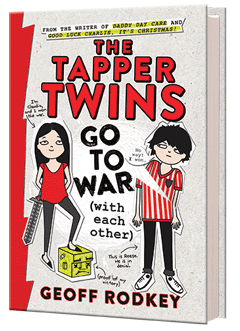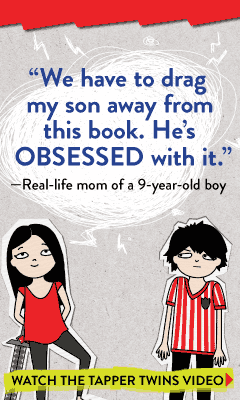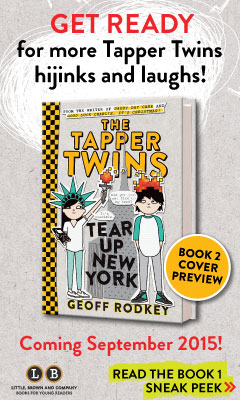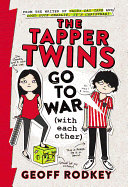The Tapper Twins Go to War (with Each Other)
by Geoff Rodkey
Geoff Rodkey (The Chronicles of Egg) delivers an engaging mash-up of history, gaming, social media and family dynamics in this launch to a planned four-book series starring 12-year-old twins Claudia and Reese Tapper.
Claudia, the more academically minded of the twins, explains in the prologue that "Wars are terrible things. I know this because I've read about a lot of them on Wikipedia." The book serves as Claudia's oral history about "the war" with Reese: "[L]ike all wars, when it was over, somebody had to write a book about it (me), so that historians of the future would know exactly what happened and whose fault it was (Reese's)."
Rodkey sets up the narrative like a screenplay, and events unfold through the voices of the twins themselves. The innovative format also layers in photos, screenshots (where appropriate) and text messages between the twins' two working parents. These juxtapositions allow for a great deal of humor, as readers fill in the gaps between the various--sometimes contradictory--points of view. The author incorporates all of these elements from the start, artfully teaching readers how to read the story.
Claudia offers nuggets about real war history, such as displaying a photo of the attack on Pearl Harbor, as akin to the start of the "war" between Reese and her: "Just like World War II, it involved a sneak attack on a peaceful people who never saw it coming (me)." Reese, who means no malice but is just a bit focused on other things, such as his MetaWorld game (think Minecraft), dismisses Claudia's characterization. "I mean, yeah, it got out of hand for a while there," says he, "but it's not like anybody died. Except on my MetaWorld account. That was a horrible, bloody massacre."
As Reese mounts his defense, his statements also appear in the screenplay, verbatim. However, as the keeper of the oral history, Claudia gets to offer commentary. For instance, while she asserts that the "war" began with a "sneak attack" in their school cafeteria at 8:27 a.m. on September 8th, Reese contends that it started earlier that morning, when Claudia ate his toaster pastry. The "sneak attack" refers to someone passing gas in the school cafeteria, and Reese accusing Claudia ("Just admit it, Princess Farts-a-Lot!" he cries, and the nickname sticks).
Threaded throughout these spars between siblings, Rodkey allows glimpses into their daily lives: a photo of their New York City apartment building on the Upper West Side, a headshot of their aspiring actress "after school sitter/substitute parent" Ashley, a photo of the M79 bus that takes them to their Upper East Side school and neighborhood haunts such as Zabar's.
Claudia gets Reese back with "Operation Fishy Revenge" (sticking a fish in Reese's backpack). None of the other Tappers can track down the source of the smell. This results in one of the funniest text exchanges between the twins' parents.
"Dad: I think a mouse died in coat closet. Really stinks in there.
Mom: Did you get rid of it???!!!
Dad: No time. Had to go to work. Left message for Ashley to search closet."
Reese then involves his friend Xander in a payback plan for Claudia, and invites him to spend the night. Xander captures Claudia on video, singing about her crush and playing guitar, and posts it to the Internet (it goes viral as "The Vest Song"). Through the exchanges among classmates, the twins' parents and school administrators, Rodkey explores the fallout from cyberbullying. The author manages to handle the topic with both seriousness of purpose and a tongue-in-cheek critique of the ramifications of a "zero-tolerance" policy, which at first serves Claudia's purpose, but then backfires down the road.
Claudia figures out how to fix her brother and Xander: by messing with their MetaWorld fiefdoms. Eighth-grader Akash Gupta, co-creator of Planet Amigo, where Reese and Xander go to fight their virtual deathmatches, serves with Claudia on Student Government and agrees to tutor her. In an amusing twist, Rodkey demonstrates how even she finds the game "terribly addictive." Claudia names her avatar InvisibleDeath and begs Akash to bend the rules for her (so she can retaliate). Akash, as "God of Planet Amigo," delivers some of the wisest lines in the book.
Rodkey creates siblings with contrasting personalities whose dynamics will be immediately recognizable to readers. His choice to let the twins tell their story in their own words results in a multi-layered, complex exploration of families, school and social mores. The antics fall away to reveal a more serious side to pranks gone awry. Beneath it all, the author reveals the underlying affection between Claudia and Reese ("Even though my brother can be incredibly annoying," says Claudia, "he is basically a good person"; Reese says, "Just because I hate you, doesn't mean you're not awesome") and a credible, likable family. --Jennifer M. Brown, children's editor, Shelf Awareness








 Geoff Rodkey does not live on Manhattan's Upper West Side, where the Tapper twins reside. He, his wife and their three children (ages 14, 12 and 9) live downtown, in Greenwich Village. Rodkey grew up in Illinois, and credits his Midwestern childhood with his ability to "still have a bit of the outsider sense" of the city. "My kids, who have grown up here, have no idea how weird [New York] is, compared to the rest of the world," he adds. "The fundamental thing is the pedestrian lifestyle, walking everywhere." That's what gives Claudia and Reese, the 12-year-old Tapper twins, such relative independence. Here he discusses the seeds of his planned four-book series.
Geoff Rodkey does not live on Manhattan's Upper West Side, where the Tapper twins reside. He, his wife and their three children (ages 14, 12 and 9) live downtown, in Greenwich Village. Rodkey grew up in Illinois, and credits his Midwestern childhood with his ability to "still have a bit of the outsider sense" of the city. "My kids, who have grown up here, have no idea how weird [New York] is, compared to the rest of the world," he adds. "The fundamental thing is the pedestrian lifestyle, walking everywhere." That's what gives Claudia and Reese, the 12-year-old Tapper twins, such relative independence. Here he discusses the seeds of his planned four-book series.